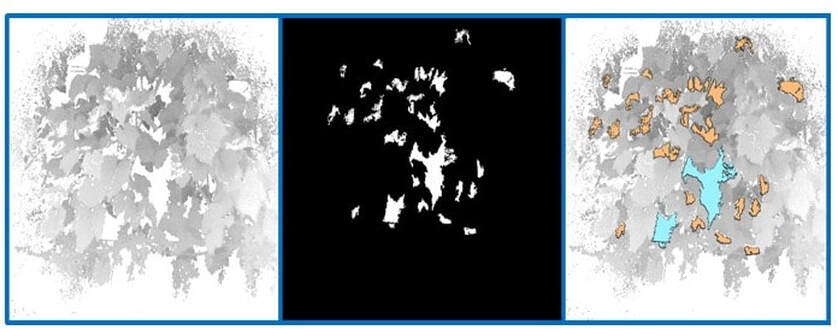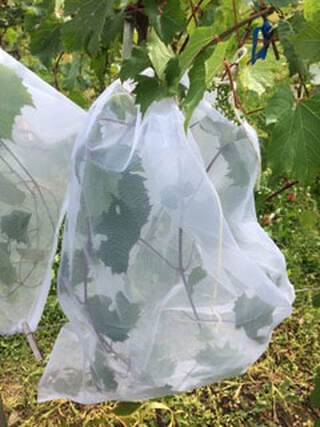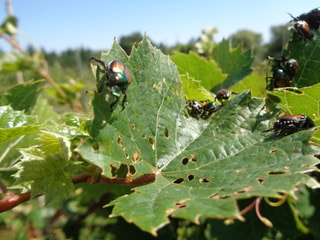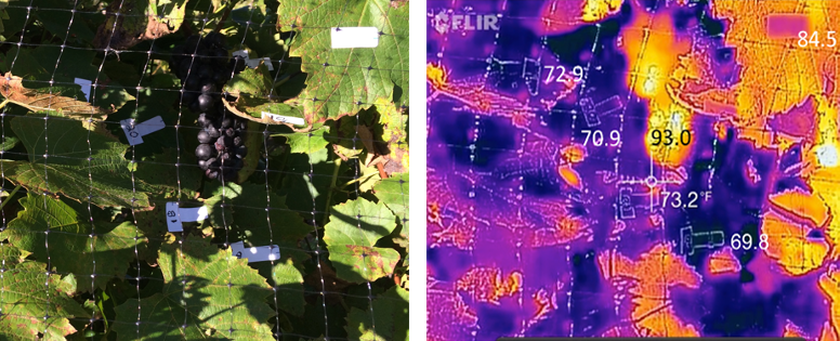 Canopy gap detection. Left: Original canopy image constructed from ten images. Middle: Binary inversion to clearly isolate 'blobs' where the Kinect IR laser beam passes through the leaf canopy and does not reflect back. Right: Gaps colored to overlay the original image, showing both major (blue) and minor (orange) gaps. Measures of vine canopy density all have the goal of evaluating light penetration into the leaves and fruiting zone. Light that fosters growth and fruit maturation. Laser beams are a perfect analogue to natural light. Like natural light, some laser beams pass freely through openings along their path through the grapevine canopy, while others are blocked by leaves. I have always thought that one of Richard Smart’s most creative measures of canopy density and balance was “canopy gaps”. It is, in fact, a measure of how open the leaf canopy is to light penetration. If you look at a VSP canopy from the side, the “gaps” are the places where light can pass through from one side of the vine to the other, unimpeded by leaves or fruit. Or think of it as the spaces where you can see through the leaf canopy. If you can see through 30% of the leaf canopy, the vine gets a high score for being in balance. For years, I have eye-balled these canopy gaps in my vines. But I never had any idea how accurate my observations were. Using a MS Kinect LIDAR device (cost $149) and several image processing steps, Chuck Hisamoto and Kale Hedburg from Aster Labs LLC, and I built a system that provides almost a perfect measure of gaps in the grapevine canopy. Much more accurate than what the human eye can estimate or even what can be estimated by the tedious use of manual point quandrant methods. And it does it almost instantly. We also have conceived a method for automatically measuring the number of leaf layers in the canopy, another key measure of canopy density from Richard Smart. It uses the same low cost consumer LIDAR technology. We are looking for funding or investment to further pursue the implementation of that technology. I have always wondered about how much the temperature varies throughout the vine’s canopy, from shady areas to sunny areas. I have also wondered about how grape clusters, with their dark skins and thermal mass, accumulate heat during the day and dissipate heat at night, relative to the leaves. Thermal imaging is one way to paint a picture of temperature variations in the canopy. Thermal imagers have become consumer products. For less than $200, you can buy a FLIR One thermal imager that snaps into an iPhone and runs from an iPhone app.
The two images above give you an idea of what you can see through an infrared camera (right) compared to a visual spectrum camera (left). It's the exact same scene in both shots. The ambient air temperature is 84 degrees F. The thermal image of the grapevine canopy on the right shows a 15 degrees F temperature difference between an exterior leaf (84.5 degrees F) and a completely shaded leaf (69.8 degrees F). What does it matter? Well, photosynthesis in grapevines is optimal between temperatures of 77 degrees F and 95 degrees F. Shaded leaves fall well below that zone. With this less than optimal contribution, leaf canopy and fruit development and ripening will be less that optimal. In the northern viticulture regions, that can effect fruit and wine quality. A grape cluster is the bright object in the upper middle of the infrared scene. The cluster surface is heated up to 93 degrees F, which is 9 degrees F warmer than the air. Heat fosters the chemical reactions inside the berry that reduce malic acid. In the North, good cluster exposure to the sun is essential to reducing acidity and achieving balanced wines. One of the interesting things I noticed in my thermal pictures is that clusters that heated up during the day due to good sun exposure retained the heat and remained 5-6 degrees F above the ambient air temperature all night long. They did so even on nights when the air temperature dropped to 40 degrees F. Acidity reduction continued all night long, albeit at a much slower rate as the berries cooled off |
Author
Tom Plocher, owner, Plocher Vines, LLC. Archives
February 2024
Categories
|




 RSS Feed
RSS Feed